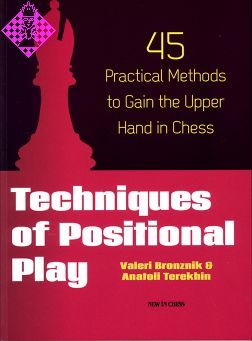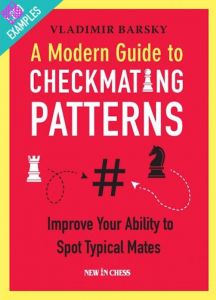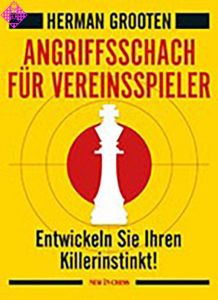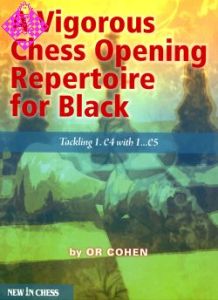Artikelnummer
LMBROTOPP
Techniques of Positional Play
45 Practical Methods ...
256 Seiten, kartoniert, New in Chess, 1. Auflage 2013
·Improved edition of a Russian instructional Classic
·Teaches amateur chess players 45 extremely effective skills in a crystal-clear manner.
·The techniques are easy to understand and to memorize
·With a special training section to test the reader’s new skills
”One of the best books on positional chess you’re ever likely to read"
Paul Kane, Manchester Chess Federation
Übersetzung des Titels "Techniken des Positionsspiels" von Valery Bronznik (Artikelnummer: LMBROTOPP) durch Ian Adams.
| EAN | 9789056914349 |
|---|---|
| Gewicht | 560 g |
| Hersteller | New in Chess |
| Breite | 15,5 cm |
| Höhe | 21,5 cm |
| Medium | Buch |
| Erscheinungsjahr | 2013 |
| Autor | Valeri BronznikAnatoli Terekhin |
| Sprache | Englisch |
| Auflage | 1 |
| ISBN-13 | 978-9056914349 |
| Seiten | 256 |
| Einband | kartoniert |
| Name | New in Chess B.V. |
|---|---|
| Adresse | Rochdalestraat 4 a Alkmaar 1814 TH Niederlande |
| Internet | www.newinchess.com |
| nic@newinchess.com |
006 Symbols
007 Introduction
009 Chapter 1 Restricting the enemy pieces
050 Chapter 2 Create breathing space for your pieces
066 Chapter 3 The clash between pawn formations
082 Chapter 4 The rook pawn - an underrated fighter
106 Chapter 5 Techniques in the fight for an open file
125 Chapter 6 Some aspects of piece exchanges
142 Chapter 7 Working with the King
170 Chapter 8 Developing and activating pieces
196 Chapter 9 Along the diagonals
220 Chapter 10 Other methods
226 Chapter 11 Practical exercises
233 Solutions to the exercises
246 Index of players
250 Index of Techniques
252 Openings and types of position
254 Bibliography
007 Introduction
009 Chapter 1 Restricting the enemy pieces
050 Chapter 2 Create breathing space for your pieces
066 Chapter 3 The clash between pawn formations
082 Chapter 4 The rook pawn - an underrated fighter
106 Chapter 5 Techniques in the fight for an open file
125 Chapter 6 Some aspects of piece exchanges
142 Chapter 7 Working with the King
170 Chapter 8 Developing and activating pieces
196 Chapter 9 Along the diagonals
220 Chapter 10 Other methods
226 Chapter 11 Practical exercises
233 Solutions to the exercises
246 Index of players
250 Index of Techniques
252 Openings and types of position
254 Bibliography
When I first saw this book I’d been thinking: ”Well, sounds similar to an old book which I read
already many years ago.“ And indeed when I opened the book somewhere on the first few pages they wrote: ”Translated from Techniken des Positionsspiels im Schach […] 2005/2008“. It was great news that they finally translated this work since it was one of the most important books after I finished my basic study of positional chess. So I’m more than happy to share my knowledge about this book with you as well as showing you what’s new in this updated and revised version!
First of all, this book is dedicated to positional chess, as the title indicates. But more so it is an extension to your basic knowledge, which you gathered in other famous chess books, by providing additional motifs and ideas, 45 to be count, structured by theme (piece play, pawn play) and displayed by some old games (some may call them classic).
”45 practical methods to gain the upper hand in chess“ fits quite well, since playing positional chess means to be creative when it comes to restriction, pawn play, control over a file and so on. I would like to mention some of those techniques in the book here in this very review, so you get some appetite for more.
But before I start, let me point out something about this edition. It has been rearranged, so that the different motifs are gathered under one general theme such as pawn play or piece play. Additionally some exercises were added, drawn from ”superfluous“ examples.
The first technique or idea, which is still very fresh in my mind, because the description kept me entertained for many years, is one which is connected with an old rule by Steinitz on how to tame knights.
Technique No. 1 is therefore called ”Putting the knight in chains“ and is quite simple: A knight standing on g6, is in general not on its’ most natural square, but has independent ideas such as Ng6-f4 or Ng6-h4 to put pressure on some kingside or central squares. If a pawn moves from g2 to g3, it controls all those squares, which certainly puts the knight in chains. Furthermore, adding the possibility of playing h2-h4-h5, hitting the knight and forcing it to come up with a new destination, is what highlights this technique!
Technique No. 17 Rubinstein’s exchange: Nbd7 the sign for cxd5
If Black plays a Queen’s Gambit declined, he often searches for pawn breaks. One of those is the push …e7-e5, which is the reason why he puts a knight to d7, to support the break. The idea behind this technique is the following: If the opponent has a setup in mind, how to deploy his pieces so they aim at the ”most natural“ idea in the position, try to change the nature of the position (i.e. by exchanging on d5 cxd5 cxd5) so that the initial push has some drawback (in that case: isolating the pawn on d5). After that exchange, the opponent’s pieces will be misplaced, because they aimed at a positional goal which is no longer available.
Those techniques are very useful and often underestimated. There are many of those little secrets within these pages. Those of you who have a passion for a king hunt may be interested in the chapter dedicated to the h-pawn and how it can be used to open up lines against the king!
All in all a good book and I’m happy that it found a publisher who got interested in sharing this great book with all chess players. The print, text and editing is great and it makes fun to read that book. A chess board is not necessary, but might come in handy in some positions, where a certain idea is shown.
Conclusion:
My recommendation goes to all players rated from 1500-1600 upwards, who are interested in some positional themes which may not be covered in basic books on positional/strategical chess. In my opinion already a classic among chess literature! My gratitude goes to NewInChess, well done!
Lukas Wedrychowski
DailyChess.org lectures & reviews
already many years ago.“ And indeed when I opened the book somewhere on the first few pages they wrote: ”Translated from Techniken des Positionsspiels im Schach […] 2005/2008“. It was great news that they finally translated this work since it was one of the most important books after I finished my basic study of positional chess. So I’m more than happy to share my knowledge about this book with you as well as showing you what’s new in this updated and revised version!
First of all, this book is dedicated to positional chess, as the title indicates. But more so it is an extension to your basic knowledge, which you gathered in other famous chess books, by providing additional motifs and ideas, 45 to be count, structured by theme (piece play, pawn play) and displayed by some old games (some may call them classic).
”45 practical methods to gain the upper hand in chess“ fits quite well, since playing positional chess means to be creative when it comes to restriction, pawn play, control over a file and so on. I would like to mention some of those techniques in the book here in this very review, so you get some appetite for more.
But before I start, let me point out something about this edition. It has been rearranged, so that the different motifs are gathered under one general theme such as pawn play or piece play. Additionally some exercises were added, drawn from ”superfluous“ examples.
The first technique or idea, which is still very fresh in my mind, because the description kept me entertained for many years, is one which is connected with an old rule by Steinitz on how to tame knights.
Technique No. 1 is therefore called ”Putting the knight in chains“ and is quite simple: A knight standing on g6, is in general not on its’ most natural square, but has independent ideas such as Ng6-f4 or Ng6-h4 to put pressure on some kingside or central squares. If a pawn moves from g2 to g3, it controls all those squares, which certainly puts the knight in chains. Furthermore, adding the possibility of playing h2-h4-h5, hitting the knight and forcing it to come up with a new destination, is what highlights this technique!
Technique No. 17 Rubinstein’s exchange: Nbd7 the sign for cxd5
If Black plays a Queen’s Gambit declined, he often searches for pawn breaks. One of those is the push …e7-e5, which is the reason why he puts a knight to d7, to support the break. The idea behind this technique is the following: If the opponent has a setup in mind, how to deploy his pieces so they aim at the ”most natural“ idea in the position, try to change the nature of the position (i.e. by exchanging on d5 cxd5 cxd5) so that the initial push has some drawback (in that case: isolating the pawn on d5). After that exchange, the opponent’s pieces will be misplaced, because they aimed at a positional goal which is no longer available.
Those techniques are very useful and often underestimated. There are many of those little secrets within these pages. Those of you who have a passion for a king hunt may be interested in the chapter dedicated to the h-pawn and how it can be used to open up lines against the king!
All in all a good book and I’m happy that it found a publisher who got interested in sharing this great book with all chess players. The print, text and editing is great and it makes fun to read that book. A chess board is not necessary, but might come in handy in some positions, where a certain idea is shown.
Conclusion:
My recommendation goes to all players rated from 1500-1600 upwards, who are interested in some positional themes which may not be covered in basic books on positional/strategical chess. In my opinion already a classic among chess literature! My gratitude goes to NewInChess, well done!
Lukas Wedrychowski
DailyChess.org lectures & reviews
"45 Practical Methods to Gain the Upper Hand in Chess" von Valeri Bronznik und Anatoli Terekhin, jüngst erschienen bei New in Chess, ist zwar eine Neuerscheinung, aber als Übersetzung des Werkes "Techniken des Positionsspiels im Schach". Wie unschwer aus dem Titel erschlossen werden kann, ist der Weg diesmal anders als gewöhnlich beschritten worden - ein im Deutschen erschienenes Buch ist ins Englische übersetzt worden. Das deutsche Werk ist 2005 vom Verlag Kania herausgebracht worden und auch noch im Handel erhältlich. Während es 22,50 Euro kostet, ist "45 Practical Methods to Gain the Upper Hand in Chess" für 24,95 Euro zu haben.
Unter Hinweis auf die online zu findenden zahlreichen Rezensionen der deutschen Ausgabe gehe ich nicht weiter auf die Inhalte des neuen Werkes ein. Das englischsprachige Inhaltsverzeichnis sieht wie folgt aus:
1: Restricting the enemy pieces
2: Create breathing space for your pieces!
3: The clash between pawn formations
4: The rook pawn - an underrated fighter
5: Techniques in the fight for an open file
6: Some aspects of piece exchanges
7: Working with the king
8: Developing and activating pieces
9: Along the diagonals
10: Other methods
11: Practical exercises.
Fazit: "45 Practical Methods to Gain the Upper Hand in Chess" dürfte auf dem deutschen Markt eher die Schachfreundinnen und Schachfreunde ansprechen, für die Deutsch nicht die Muttersprache ist und die Englisch bevorzugen. Für sie bietet sich nun also die Gelegenheit, ein in der Schachwelt anerkanntes Buch in englischer Sprache zu erhalten.
Mit freundlicher Genehmigung
Uwe Bekemann, Deutscher Fernschachbund
www.bdf-fernschachbund.de
September 2013
<A class="inhalt" href="../../../dbbilder/leseprob/LMBROTOPP Rezension Rieger 20130901.pdf"><b>Rezension M Rieger 2013/09 im PDF-FORMAT</b></A>
Unter Hinweis auf die online zu findenden zahlreichen Rezensionen der deutschen Ausgabe gehe ich nicht weiter auf die Inhalte des neuen Werkes ein. Das englischsprachige Inhaltsverzeichnis sieht wie folgt aus:
1: Restricting the enemy pieces
2: Create breathing space for your pieces!
3: The clash between pawn formations
4: The rook pawn - an underrated fighter
5: Techniques in the fight for an open file
6: Some aspects of piece exchanges
7: Working with the king
8: Developing and activating pieces
9: Along the diagonals
10: Other methods
11: Practical exercises.
Fazit: "45 Practical Methods to Gain the Upper Hand in Chess" dürfte auf dem deutschen Markt eher die Schachfreundinnen und Schachfreunde ansprechen, für die Deutsch nicht die Muttersprache ist und die Englisch bevorzugen. Für sie bietet sich nun also die Gelegenheit, ein in der Schachwelt anerkanntes Buch in englischer Sprache zu erhalten.
Mit freundlicher Genehmigung
Uwe Bekemann, Deutscher Fernschachbund
www.bdf-fernschachbund.de
September 2013
<A class="inhalt" href="../../../dbbilder/leseprob/LMBROTOPP Rezension Rieger 20130901.pdf"><b>Rezension M Rieger 2013/09 im PDF-FORMAT</b></A>
Mehr von New in Chess
-
 Associative Thinking (hc)34,95 €
Associative Thinking (hc)34,95 € -
 Aron Nimzowitsch 1928 - 193534,95 €
Aron Nimzowitsch 1928 - 193534,95 € -
 After Magnus14,95 €
After Magnus14,95 € - Mehr von New in Chess





